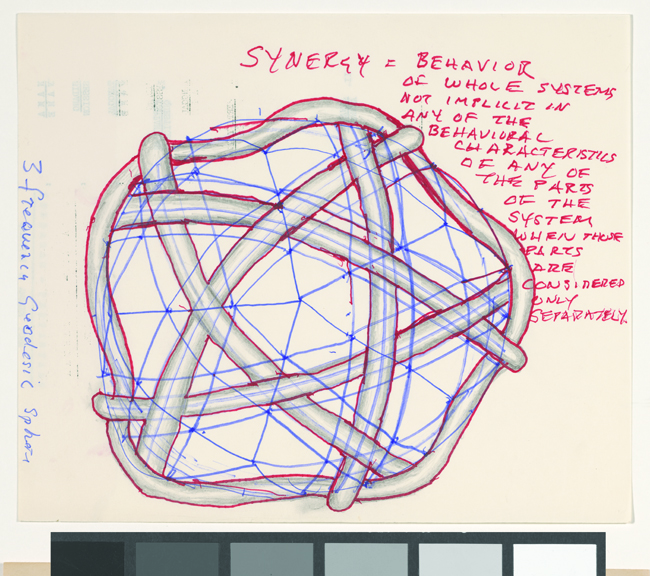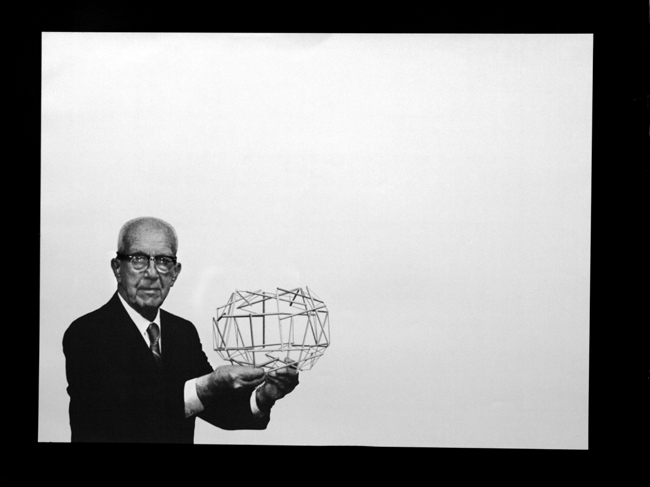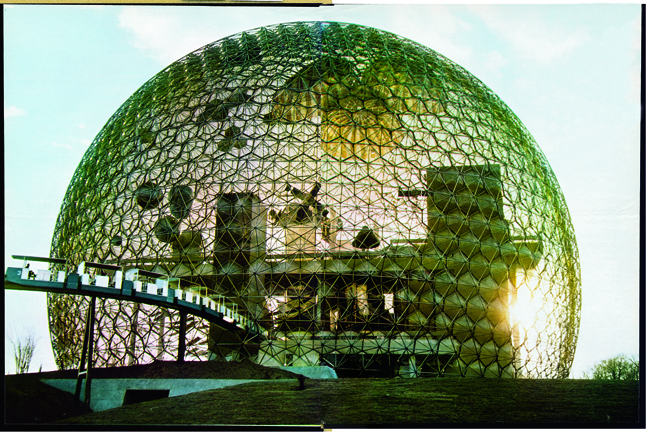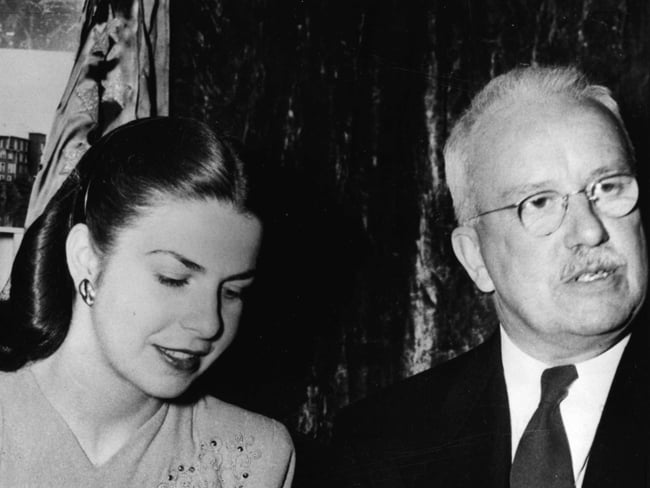
July 19, 2016
Antennae to Experience: What Bucky Fuller Taught Me
Buckminster Fuller’s daughter shares a previously unpublished essay and reveals a rarely spotlighted side to the revered thinker.

Allegra Fuller Snyder and her father, Buckminster Fuller, in the 1950s.
All Images Courtesy The Estate of R. Buckminster Fuller
—On the occasion of Bucky’s 100th birthday, July 12, 1995
My father was a warm, concerned, and sharing father. As focused as he was on his own work, he nevertheless included me in his experiences and his experiencing. I remember with great clarity when I was about four years old, I was sick in bed, and he was taking care of me. He sat down on the bed beside me with his pencil in hand and told me—through wonderful freehand drawings—a Goldilocks story. I was Goldilocks, and with his pencil he transported me not to the bears’ house, but to the universe to help me understand something of Einstein’s theory of relativity. In later years, reflecting on Einstein himself, my father would often repeat, “Change is constant, change is normal.” But that had been a phrase I had heard, as Goldilocks, in the very earliest days of my own thinking. What he was telling me was neither remote nor abstract. I was in a newly perceived universe. I was experiencing my father’s thoughts and he was experiencing his own thinking as he communicated with me. It was exciting. We were sharing something together, and I felt very warm and close to him in that experience.
I also shared very participatorily in the emergence of the Dymaxion car, visiting the plant in Bridgeport, Conn., as his vision came to life, riding with him as he tested first the chassis, and then the whole car
and its many marvels. I was then six or seven. After he published Nine Chains to the Moon, I was, at 12, an active part of the first seeding of synergetic geometry. I loved numbers and patterns of numbers and was a witness as these numbers began to take on shape and form, a three-dimensional geometry. He asked me to work alongside him in that process.
As I review all of these experiences, and I review my life in its relation to my father, there emerges a central core, something that was a key to so much else. I begin to perceive something that I learned very fundamentally from my father, which was essential in his own work and became a seed that flowered into much of my own life and work. To tell you about that core, I have to tell you something about myself.
I have pioneered a field called dance ethnology. A dance ethnologist is one who is concerned with studying the process of dance in culture. My work calls for a comprehensive perspective that seeks out that pattern of human behavior called dance and asks what its functions are in world societies. This field of investigation has been the major focus of my work and life for the last 30-plus years.
I came to dance, as every child does, because it was one of those natural, first, nonverbal responses to life—after walking, almost always comes dancing. What, perhaps, made my experience different from that of most children, however, was that as I “grew up” and entered school, this experience was not negated. Nor was I told that I should now be a good girl and just sit still and listen to what others told me. I went to an extraordinary school in New York called Dalton, which was founded on the educational thinking of a woman named Helen Parkhurst. Miss Parkhurst, in turn, had evolved a part of her work on the principle of John Dewey’s “learning by doing.” Through Dalton I came to know dance as a way of knowing that was as indispensable and critical as any other way of knowing.
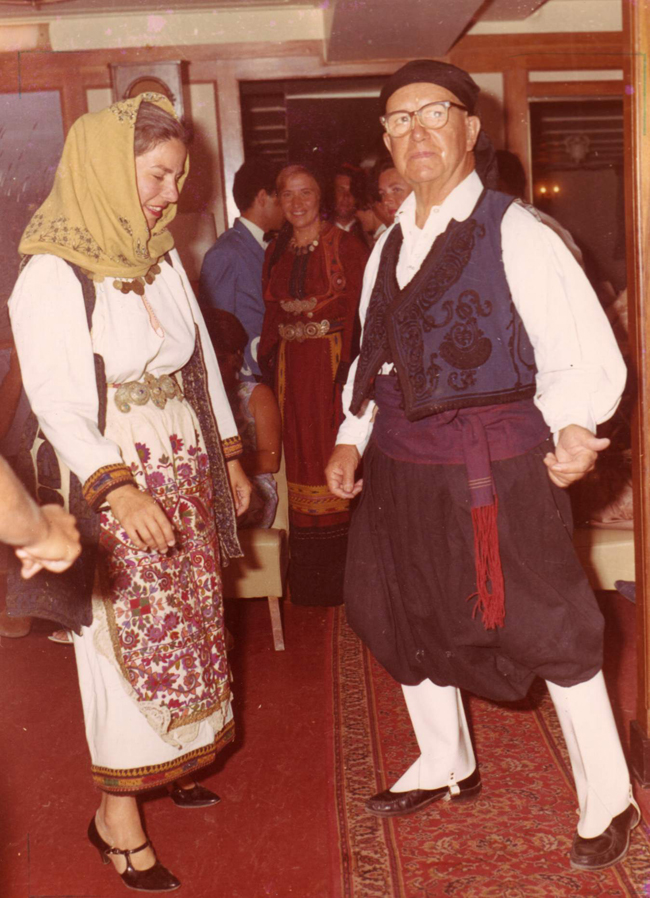
Snyder and her father in Greek costume at the Delos Symposium in 1966. The symposium, held aboard the yacht of the Greek architect-planner Constantinos Doxiadis, facilitated discussions surrounding ekistics—the study of human settlements.
Let me tell you very briefly about this educational process. In the third grade we spent the year focused on the origins of man. We came to the dinosaur age, I did a dance, or rather I experienced and communicated through movement, about dinosaurs and how some got stuck in the La Brea tar pits. Then there was a dance about the solar system, as we continued forward in our exploration of the universe. The following years we were submersed first in the history of Egypt, then Greece in the fifth grade, and the medieval period, through medieval China and India as well as Europe, in our sixth year. All these studies were brought to a culmination and integration by an “experiencing,” a performance, of which dance was a critical part. My understanding of these moments in history, and of ideas that were vital to them, was, and is, embedded in my viscera. This was a form of self-education of which Bucky spoke so often, for experiential learning is self-generated and self-propelled, particularly in a supportive environment.
My father had carefully sought out Dalton and, though it was a private school and quite expensive, he found a way to borrow on, or barter, his work so I could attend that school and learn through that process. Providing this kind of education for me was hard for him financially, but he saw in this curriculum something of the “progressively coordinated apprehension and comprehension of universe” that he felt “the mind was spontaneously prone to deal with.” This, he felt, was the essence of education.
It is the relation between the mind, which Bucky so often talked about, and experience or experiencing that I found to be the key that unlocks his work and inspired my own. I believe inherently that Bucky’s concept of mind has, at its base, mind processing through experience. By “experiencing” I mean involving one’s whole self, not being present at, or observing, something, but “doing” that thing. I remember how my father always loved to wash dishes. I had a perfectly good dishwasher, a piece of excellent technology, but he preferred to get his hands wet, to rinse, soap, and stack the dishes in just the right way. (Technology, from my father’s point of view, was always an extension and enrichment of experience, not a substitute for experience.)
One of the most vivid images I have of my father is of his fingertips. I can see him sitting with his eyes closed, searching deeply into his mind/experience, with his fingertips barely tapping together or his hands reaching out in one of those broad and animated gestures so common in later years when he lectured. His fingertips were exploring the universe around him. His fingertips were his antennae to experience. What he processed in his mind was only ever processed through that link to experience. The largest concepts, his generalized principles, were a summarization and culmination of what he called “special-case experience.” Many times his fingertips seemed to suggest that he was tuning in to, was in touch with, that special-case experience.
What is so important to recognize is that this was physical experience. My father was a very physical person. He used to pride himself on being quite an athlete. It was a knee injury, in his last year at Milton Academy or just before he entered his first year at Harvard, that may have very well shifted the directions of his life, for when he thought of going to Harvard it was with great visions of playing football and hockey and “making the team.” He didn’t because of his knee, and his energies shifted elsewhere, at first mostly toward other forms of physical pleasure—parties and such—and for that he was dismissed from Harvard.
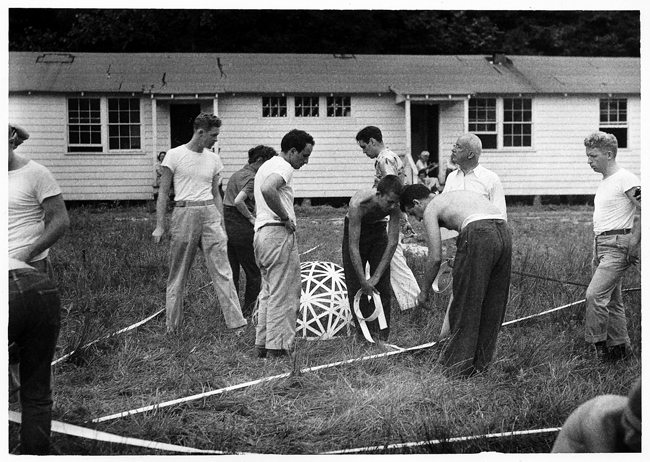
Bucky works with students on the construction of the Supine Dome at Black Mountain College in North Carolina in 1948.
Courtesy Winslow Wedin/The Estate of R. Buckminster Fuller
He was sent to work as an apprentice millwright in a cotton mill in Sherbrooke, Quebec. He loved it. It was tangible as well as physical work, and he was transformed by the experience. He was accepted back again at Harvard, but once he was there he felt that all he was asked to do was memorize, not validate through experience. He rebelled, and again he was dismissed. The commencement of World War I followed immediately thereafter. He went to Annapolis, where, in the navy, he discovered again the “hands on” and the physical. For my father, the direct sensorial understanding and application embodied in his navy experiences were a turning point. It set a course that very critically affected the rest of his life.
My father was a walker. When he was courting my mother, who lived in Brooklyn Heights, he would walk down from the mid-thirties in Manhattan, where he lived with his mother, across the Brooklyn Bridge and into Brooklyn Heights, about a ten-mile walk, to see my mother and home again. He once told me about walking an extraordinary number of miles, perhaps 100, to see my mother during one of his weekend leaves from the navy, just after they were married. This was his best thinking time. His thinking was connected to his body.
It was an integration of his body and his mind. This is what dance is, as I have come to understand it. He intuitively made this connection too, so he had no difficulty in understanding and supporting my interest in dance. And I felt no great separation between my own essential interests and what lay at the core of his work.
It is the sense of the physicalization of ideas that I see as so important in understanding and accessing my father’s work. It is the sense of physicalization that propels synergetics, or holistic thinking, and sets the criteria in his demand for a “modeling universe.” I don’t think one can really confront Bucky’s work without turning to the resource of one’s own experiences and the wiliness to use those experiences as a basis for understanding. Understanding is an experiential word, particularly used in this context, with its sense of the necessity of actually “standing” physically “under” an idea and experientially supporting the concept.
He loved Bear Island, our family-owned island in Maine, because it was a physically involving place. We had no freshwater, except cistern-caught rain and well water— which had to be drawn or pumped and then hauled—kerosene and candles for light, a fire in the hearth for heat. Each of these basic requirements involved physical action to produce the needed results. And then, of course, there was sailing, which he loved, where the dialogue between nature and human action is so dynamic.
At the heart of each one of these actions was the sense of the “special case” that would lead to a generalized principle. Any experience would become a special case, the doorway to larger comprehensivity. When you were around him you were aware of how sensitive he was to the smallest experience. His focus could zero in on a pebble on the beach, a twig or flower along a path. Each became the stepping-stone to the largest whole. “The human brain apprehends and stores each sense-reported bit of information regarding each special-case experience,” he said. “Only special-case experiences are recallable from the memory bank.”
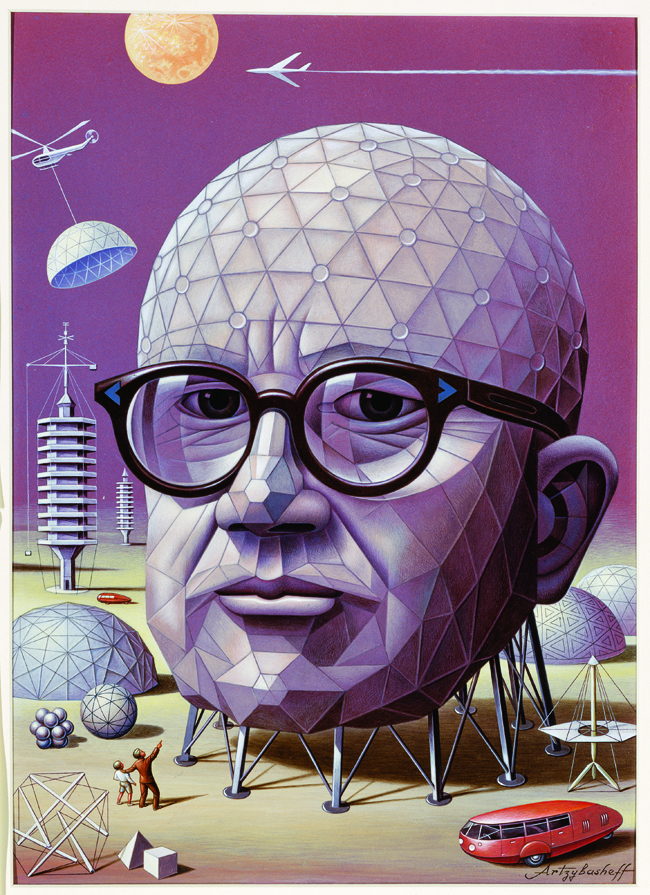
Portrait of Buckminster Fuller by Boris Artzybasheff
Bucky didn’t use the word feeling often, but he quotes this wonderful E.E. Cummings thought at the beginning of his book Critical Path. I believe what Cummings meant by “feel” and “feeling” relates to Bucky’s “experience” and “experiencing”:
A lot of people think or believe or know they feel [experience]—but that’s thinking or believing or knowing; not feeling [experiencing]. Almost anybody can learn to think or believe or know, but not
a single human being can be taught to feel [experience]. Why? Because whenever you think or you believe or you know, you’re a lot of other people. But the moment you feel [experience], you’re nobody but yourself. To be nobody but yourself—in a world which is doing its best, night and day, to make you everybody else—means to fight the hardest battle which any human being can fight; and never stop fighting.
That was the scenario of Bucky’s life—to fight the hardest battle that any human being can fight and never stop fighting. Intuition and imagination both relate to and are a part of experience. Let me turn for a moment to Bucky’s own words on these matters. (What follows is drawn from E.J. Applewhite’s wonderful Synergetics Dictionary.)
Intuition is practically physical, the kind of supersensitivity that a child has.
Imagination. Image-ination involves rearranging the “furniture” of remembered experience as retrieved from the brain bank.
Speaking with an audience, Bucky would say, “All that I can really give you I must always identify by experience.” One of his great gifts as a speaker was the fact that he made you experience his ideas and carried you along with the connection between your experience and his experience. “Information is experience. Experience is information.” He then goes on to really explore the essence of experience:
Thinking is inherently exclusive. Experience, which comes before thinking, is inherently inclusive.
Experience is complex consciousness of being, of self, co-existing with all the non-self.
Re-experienced consciousness is re-cognition. Re-cognitions generate identifications. Re-cognition of within self rhythms, of heart beatings or other identities, generate a matrix continuum of time consciousness upon which, like blank music lines, are superimposed all the observances by self of the non-self occurrences.
Experience is inherently discontinuous and islanded and each special experience represents a complex of generalized principles operative in special or limited-size modulated realization.
Experience is finite; it can be stored, studied, directed; it can be turned, with conscious effort to human advantage. [This means that] evolution pivots on the conscious, selective use of cumulative human experience.
Universe is the coordinate integral of all experience.
Where or how does experience continue to be a part of the picture when, as Bucky pointed out, “at the dawning of the 20th century, without warning to humanity, the physical technology of Earthians’ affairs was shifted over from a brain-sensed reality into a reality apprehended only by instruments”? His response was that invisibility can be “understood and coped with only by experience-educated mind.”
Let me turn again, for a moment, to my own work in hopes of clarifying this very important point. It is my observation that dance is most significant in those societies that are least literate, where they have had no need for a tool to document the spoken word, and it is least significant in societies, such as our own, where literacy, rather than knowledge and understanding, is set up as the criteria of education and cultivation. Since I have learned a very great deal from understanding dance, what does this tell me? The written word was and is an extraordinary technological tool, but it was the first step in the separation of knowledge from experience. It extended knowledge, in time and space, but away from self and made invisible, and often forgotten, the source of knowledge, the reason for knowledge. There are trade-offs in the process of literacy that I think are very important to examine. Literacy allows detachment, lack of involvement, sometimes, and most important of all, irresponsibility to the essential understanding and retention of knowledge. Physical conceptualization is deeper and more lasting as a learning process, and the individual is propelled into a sense of responsibility by that process; that, I think, is why Bucky said invisibility can be “understood and coped with only by experience-educated mind.”
From my perception of reality, and orientation to life, all of the above suggests that in order to really understand Bucky’s work, you must, in essence, be a dancer yourself. You must understand your body and experience as a way of knowing. In a functional way the ideas need to be embodied in your own thinking/experiencing. My father was at his most essential “Bucky” when he burst into his wonderful clogging dance. He was a dancer in the way I understand dance, as a way of knowing, and his understanding of universe was through his dancing in his mind.
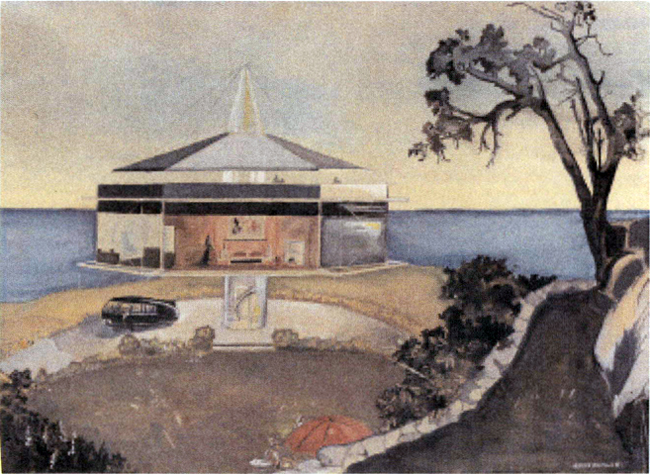
A painting, done by Bucky’s wife and Snyder’s mother, Anne Hewlett Fuller, in 1932, depicting the never-realized 4D Dymaxion house with the Dymaxion car parked out front.
Courtesy Anne Hewlett Fuller/The Estate of R. Buckminster Fuller
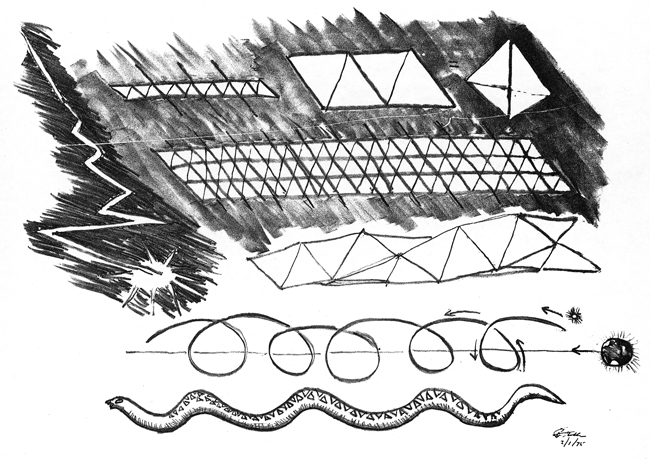
In addition to talking about his processes in simple terms, Fuller often worked through them via freehand drawings and sketches.
